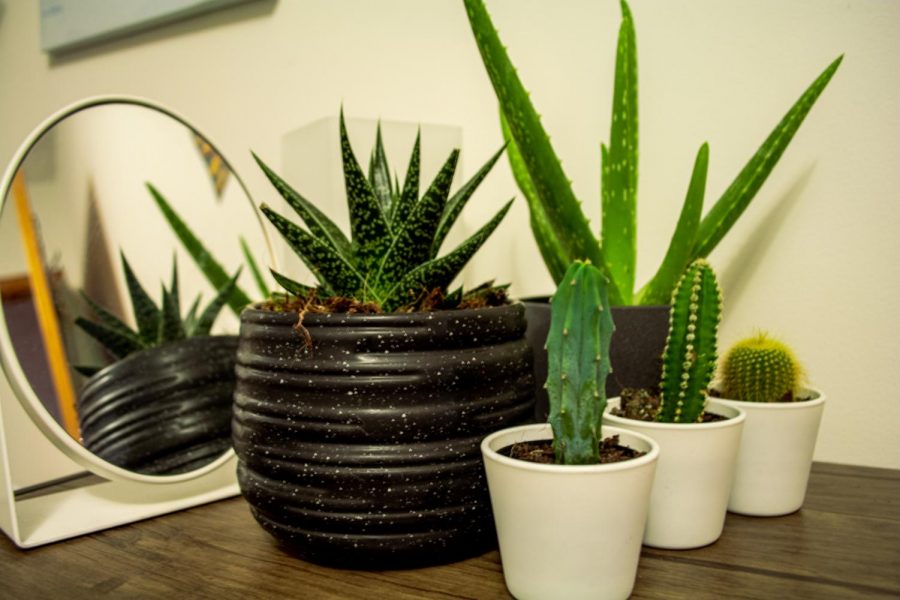Read this before you kill your succulents
Just because they can tolerate droughts and extreme heat doesn’t mean they can tolerate your incompetence. Here’s how to not kill your latest dorm room decoration.
Succulents are known for their ability to handle extreme heat and low maintenance. While succulents are a popular choice of dorm room plant decoration, poor treatment can cause them to die. (Staff Photo by Manasa Gudavalli)
August 30, 2021
Succulents are beautiful plants. From the otherworldly Lapidaria margaretae to the humble aloe, they’re popular for their fascinating leaf patterns, stunning blossoms and charming personalities. Who wouldn’t want one for their dorm or apartment?
They’re also not as indifferent to mistreatment as their reputation would lead you to believe. If you keep buying cute succulents at the grocery store that were grown in a sunnier state only for them to repeatedly die on you, you might need to change your approach. Here’s how to do it right.
Light
These are desert plants, not studio apartment plants.
Succulents, broadly speaking, need a lot of light. More light than you can likely provide, in fact. If you’re stuck in a tiny dorm room or New York City bedroom with just one window that doesn’t even face south, don’t bother — your succs will suffer.
When plants don’t get enough light, they undergo a process called etiolation. Etiolating succulents shrink their leaves and stretch out their stems, which become elongated and feeble, in search of light. Neither of these things is good for the plant and more or less defeats the visual appeal of keeping succulents anyway.
You probably bought an Echeveria because you thought the rosette was so colorful and cute, right? It’s not going to look so cute when its stem is straining for light that it’ll never reach and its vibrant leaves fade to a feeble, pale green because you did the botanical equivalent of raising a Samoyed in Arizona.
Growing healthy light-hungry succulents in this climate typically requires grow lights. If you decide to fully commit and buy some, I respect your dedication — just don’t blame me if the Resource Center finds that package suspicious. I recommend just getting plants that don’t need as much light as, say, a Lithops.
Watering
Yes, succulents do need water. No, not that much water.
By far the most common way to kill a succulent is by overwatering it. Succulents are very sensitive to excessive watering, as they’re susceptible to root rot. When there’s too much water in the soil, whether from overwatering or insufficient drainage, the plant decays from the roots up. It’s often too late to save it by the time you notice.
Don’t water your succulents like you would for your other houseplants. Depending on the species and climate, succulents like to be watered from once every two weeks to once every two months. You can ask your plant if it wants water by gently squishing a leaf between two fingers. The leaves are where succulents store water, so if the leaves squish, it means the leaves aren’t full of water and the plant will want water soon.
It’s very easy to kill a succulent by overwatering it, and it’s very difficult to kill one from underwatering it. Err on the side of caution and don’t water your succulents all the time just so you can feel like you can take care of something in your life.
On the other hand, it’s a common misconception that succulents don’t need to be watered. I can’t tell you how many times I’ve heard people saying that they just mist their succulents with a spray bottle because they don’t want to overwater them. Yes, overwatering kills succulents, but lightly dusting the plant in a fine mist that evaporates in five minutes doesn’t do them a whole lot of good either.
It doesn’t mist in the Sonoran Desert. It just doesn’t. It’s really dry for a long time, and then there’s a torrential rainstorm. Simulate that for your succulent by watering it deeply every few weeks — soak all of the soil in the pot, and let it drain fully. You do have drainage holes, right?
Planting
You had better have drainage.
You cannot grow a succulent in a completely sealed pot. Don’t even think about a glass jar, and that terrarium is a death trap.
And no, you cannot put charcoal or rocks at the bottom for drainage. Think about that for just a second. No matter what you have down there, there is no movement if the water is not going to be draining to anywhere.
If you have drainage holes, those kinds of substrates will help the water drain out of them better. But without anywhere for the water to flow through, it doesn’t matter what you have at the bottom of your pot — rocks, gravel, charcoal, excuses, whatever — it’s not going to change the fact that the water has nowhere to go.
Once you’re cured of terrarium fever, you can start thinking about the soil you’ll grow your succulents in. Let’s set down that political compass quiz and look at the soil triangle instead.
Like the political compass, the left side of the soil triangle is the good one. Clay and silt retain water well. You want a sandier soil where relatively little water is retained by relatively small amounts of organic matter. Succulents want coarse soil that drains quickly and doesn’t hold a lot of water.
You want coarse dirt with not a lot of organic matter and a lot of inorganic matter — less beautiful dense brown soil, more gritty substrates like fine gravel and bark shavings. You wouldn’t keep a freshwater fish in a saltwater aquarium, so don’t try to raise a desert plant in a tropical environment.
Store-bought succulent mix is usually fine. Try to pick one that’s as coarse as possible, though, since they’re usually a little on the wetter side.
Recommendations
Now that I’ve intimidated you into thinking that you need a Ph.D. in botany and a government-issued license to buy any kind of succulent, here are a few forgiving options for beginners.
Jade plant
These are more or less indestructible. They tolerate less careful watering than most succulents and do just fine with suboptimal light. The leaves do turn pretty shades of red and orange with full sun, but they don’t mind partial shade. I have heard of one that survived in a closed closet for months. They also multiply — larger jades will self-prune, dropping clusters of leaves that can be propagated into another jade plant. Stick the stem in some soil, water it occasionally and let the meristem cells do the rest of the work of putting out roots.
The jade plant’s cousins in the genus Crassula are some of my personal favorites — check out Crassula tetragona, C. perforata and C. capitella.
String of pearls
This is a unique succulent that produces dangling vines of green orbs. Old, well-cared-for specimens come to resemble a botanical bead curtain. They’re healthiest with more sun, but they can do well on a windowsill. In a hanging planter, they can be a striking accent for a window alcove.
Aloe vera
Who could forget aloe vera? They’re resilient, elegant and their leaves are just so juicy. Though they prefer more sun, they tolerate lower light well and are forgiving when it comes to watering. You can even harvest the leaves off of a larger plant for the gel’s health benefits.
With patience and care, an aloe will occasionally send up a flower stalk, typically in summer. Watching an aloe gradually put forth a stem and seeing the buds unfold into gorgeous red blossoms will make you feel like a proud plant parent.
Succulents aren’t as easy to take care of as you might have been led to believe, but they’re also not that easy to kill. If you do manage to kill one, remember: It’s just a plant. They’re not sentient. It’s not a big deal if you accidentally kill one. I won’t judge you — at least not to your face.
A version of this article appeared in the Monday, August 30, 2021 e-print edition. Email Alex Tey at [email protected].

























































































































































